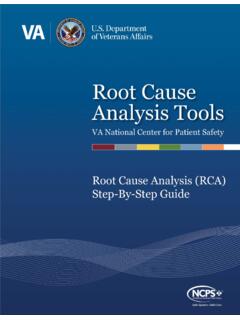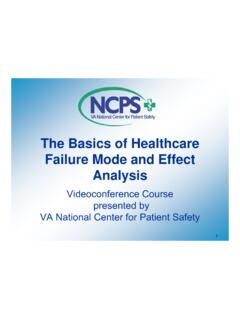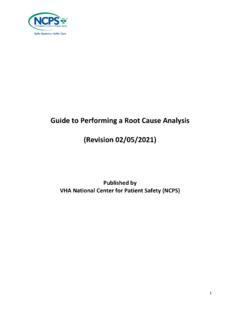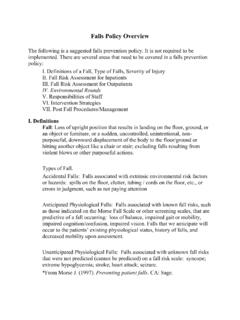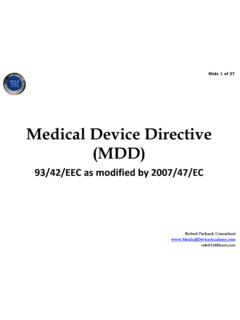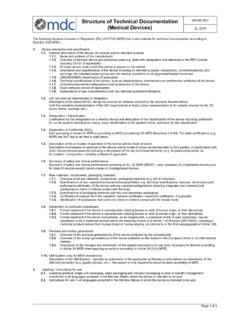Transcription of MODERATE SEDATION BY NON-ANESTHESIA PROVIDERS 1. …
1 T-1 Department of Veterans Affairs VHA directive 1073 Veterans Health Administration Transmittal Sheet Washington, DC 20420 December 30, 2014 MODERATE SEDATION BY NON-ANESTHESIA PROVIDERS 1. REASON FOR ISSUE: This Veterans Health Administration (VHA) directive establishes the policy that defines the provision of MODERATE SEDATION by PROVIDERS other than Anesthesiologists and Nurse Anesthetists. 2. SUMMARY OF CHANGES: This directive clarifies the process for obtaining privileges to administer MODERATE SEDATION and the procedures to be followed when MODERATE SEDATION is used. 3. RELATED ISSUES: None. 4. RESPONSIBLE OFFICE: The Office of Specialty Care Services (10P4E) is responsible for the contents of this directive .
2 Questions may be addressed to the National Director of Anesthesia Service at 202-461-7120. 5. RESCISSIONS: VHA directive 2006-023, dated May 1, 2006, is rescinded. 6. RECERTIFICATION: This VHA directive is scheduled for recertification on or before the last working day of December 2019. Carolyn M. Clancy, Interim Under Secretary for Health DISTRIBUTION: E-mailed to the VHA Publications Distribution List on 1/6/2015. December 30, 2014 VHA directive 1073 1 MODERATE SEDATION BY NON-ANESTHESIA PROVIDERS 1. PURPOSE: This Veterans Health Administration (VHA) directive establishes the policy that defines the provision of MODERATE SEDATION by PROVIDERS other than Anesthesiologists and Nurse Anesthetists.
3 Those individuals ordering, administering, and supervising MODERATE SEDATION in support of patient care must be qualified and have appropriate credentials, plus privileges or scope of practice. MODERATE SEDATION is the current term for what has been previously called conscious SEDATION or twilight sleep. Deep SEDATION by NON-ANESTHESIA PROVIDERS will be addressed in a separate VHA directive . NOTE: This directive does not apply to minimal SEDATION or anxiolysis (such as nitrous oxide inhalation without additional medications), during which there is no significant likelihood of loss of the airway; nor procedures carried out in intubated patients in the Intensive Care Unit (ICU) who are already being continuously monitored.
4 Monitored Anesthesia Care (MAC) provided by an Anesthesiologist or Nurse Anesthetist is not MODERATE SEDATION . AUTHORITY: 38 United States Code ( ) 7301(b). 2. BACKGROUND: MODERATE SEDATION is done routinely in VHA to increase the comfort of patients undergoing procedures and diagnostic treatments. MODERATE SEDATION can minimize a patient s pain and anxiety. Return of the patient to an alert state where safe discharge can be done is normally faster with MODERATE SEDATION than would occur with deeper forms of SEDATION . 3. POLICY: It is VHA policy that individuals ordering, administering, or supervising MODERATE SEDATION in support of patient care must be qualified and have appropriate credentials, privileges or scope of practice.
5 4. RESPONSIBILITIES: a. National Director of Anesthesia. The National Director of Anesthesia is responsible for maintaining a uniform training module for MODERATE SEDATION . The uniform training module is available at the Veteran Affairs (VA) Talent Management System (TMS) Web site ( ). b. Veterans Integrated Service Networks Directors. Veterans Integrated Service Network (VISN) Directors are responsible for ensuring that all VA medical facilities within their network implement the requirements of this directive . c. Medical Facility Directors. Medical facilities Directors are responsible for ensuring facility compliance with the following requirements: (1) Requirements for Obtaining or Renewing Full Privilege or Scope of Practice.
6 (a) An individual must demonstrate sufficient knowledge to administer, monitor, or supervise MODERATE SEDATION by obtaining a passing score on VA s TMS MODERATE SEDATION test. The passing score (established by TMS) must have been obtained no more than 90 days before the privileging/re-privileging action or scope of practice action. TMS-based MODERATE SEDATION Training is available with the test for those desiring a refresher course prior to testing. VHA directive 1073 December 30, 2014 2 (b) For transfers in from another VA medical facility, the gaining facility may rely on TMS documentation from the losing facility. (c) Successful completion and maintenance of Advanced Cardiac Life Support (ACLS) training as described in VHA policy regarding cardiopulmonary resuscitation training or as described in local facility policy.
7 (d) A period of Focused Professional Practice Evaluation (FPPE) or Ongoing Professional Practice Evaluation (OPPE) specific to MODERATE SEDATION care as defined by the facility. (2) Hospital Locations. A list of all hospital locations where MODERATE SEDATION is performed must be maintained. d. Medical Facility Chief of Staff. The medical facility Chief of Staff is responsible for ensuring that: (1) MODERATE SEDATION Pre-procedure Evaluation. (a) Staff privileged to provide MODERATE SEDATION must be involved in planning for and providing MODERATE SEDATION care to the patient. NOTE: For more information on credentialing and privileging see VHA Handbook , Credentialing and Privileging.
8 (b) The patient chart needs to include an appropriate history and a physical that was done, or updated, within 30 days of the diagnostic or therapeutic procedure for which MODERATE SEDATION will be administered. (c) The patient is informed prior to the therapeutic or diagnostic procedure for which MODERATE SEDATION will be administered that arrangements must be made beforehand for transportation home by a responsible individual, such as a family member or friend. Transportation home by Veterans Transportation Service (VTS) is acceptable when national and local VTS policy allows. (See paragraph (5)(b)(1) ). (d) Before administering MODERATE SEDATION , a licensed independent practitioner (LIP) plans or concurs with the plan for MODERATE SEDATION .
9 The LIP must document concurrence with the plan. (e) A pre- SEDATION assessment must be performed, which may include the relevant history and physical. The combination of the history and physical, along with the pre- SEDATION assessment must, at a minimum, include: 1. A review of abnormalities of the major organ systems; 2. An assessment of the airway; 3. A history of any previous adverse experience with SEDATION or analgesia, as well as regional and general anesthesia; December 30, 2014 VHA directive 1073 3 4. A review of drug allergies and current medications, to include VA and non-VA prescription, over the counter and herbal medication; 5. A review of tobacco, alcohol, or substance use or abuse; 6.
10 Time and nature of last oral intake; 7. A risk assessment, such as the American Society of Anesthesiologists Physical Status; and (f) A requirement that the patient is re-evaluated for any change(s) since the prior assessment immediately before MODERATE SEDATION and that pre- SEDATION vital signs are documented. (2) MODERATE SEDATION Staffing. (a) Sufficient numbers of qualified staff, in addition to the individual performing the procedure, must be present to evaluate the patient, help with the procedure, provide the SEDATION , monitor, and recover the patient. (b) The person performing the procedure cannot be the primary individual monitoring the patient. (c) The person monitoring the patient should not be scheduled to perform other tasks and must be in close physical proximity to the patient to enhance the ability to observe the patient.

